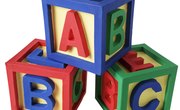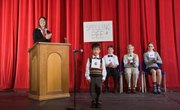According to the 2011 National Assessment of Educational Progress, 33 percent of fourth-grade students tested below basic in reading on national exams. While no single intervention strategy has been determined to be the best, successful strategies can be integrated into each of the following instructional components: methods, development of cognitive processing, individual student practice and group work.
Instructional Strategies
The Center on Instruction suggests explicit instruction as a key intervention strategy. Explicit instruction includes a standard lesson, teacher modeling of specific steps to take while reading. Modeling includes showing how to hold a book, turn its pages and sound out difficult words. Systematic instruction, or teaching each step of a skill, is another intervention strategy. Students should reach mastery of each step before a new skill is taught. For example, students may first be taught to sound out words in a story. Then, they may be taught meanings of the words. Finally, students can be taught to read a story in its entirety. According to the Center for Instruction, verbal feedback throughout a lesson is another successful intervention strategy.
Developing Cognitive Processing
Research supports developing skills in meta-cognition for learners struggling with reading. The Center on Instruction suggests modeling self-assessment and self-awareness in the classroom. For example, a teacher might state the methods she will use before encountering a difficult text, while acknowledging that she might struggle. As students engage in independent practice, the teacher might ask a student to develop a plan for understanding a difficult task.
Individual Learning Time
Students should be given the opportunity for repeated practice of individual skills. Sound manipulation activities can increase phonemic awareness and the ability to blend sounds. Segmenting sounds by speaking each syllable, repeating sounds after the teacher or reading words on a beat -- using clapping or music -- can develop phonemic awareness. Students may also use flash cards, reread texts, listen while reading along, create story maps of plot elements, paraphrase text or answer comprehension questions as the teacher reads to help increase overall vocabulary skills an reading comprehension.
Group Work
According to the Center on Instruction, small groups of three to four students are most effective for group work in reading instruction. One-on-one instruction and partnering is also effective. Partner reading pairs a stronger reader with a weaker one. The strong reader reads a passage first, and the weaker reader repeats the same passage aloud. The stronger reader can help with any difficult words, ask questions about the text and model reading strategies.
Related Articles
References
Writer Bio
Based in Los Angeles, Jana Sosnowski holds Master of Science in educational psychology and instructional technology, She has spent the past 11 years in education, primarily in the secondary classroom teaching English and journalism. Sosnowski has also worked as a curriculum writer for a math remediation program. She earned a Bachelor of Arts in print journalism from the University of Southern California.











